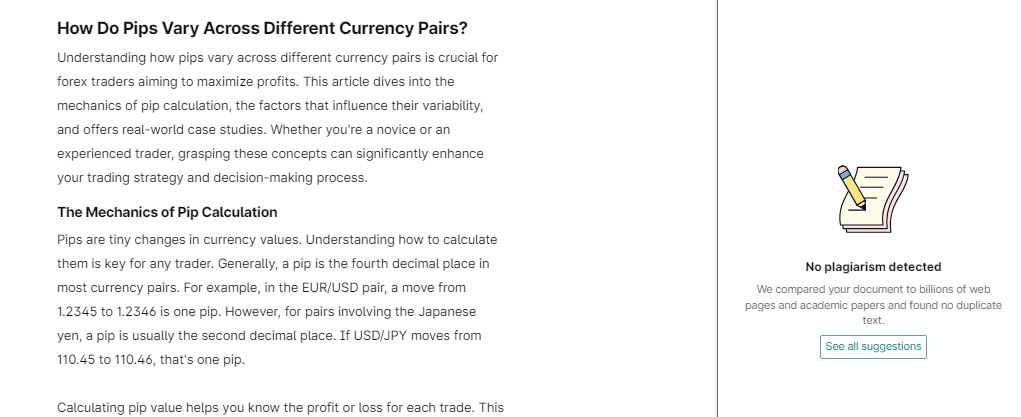Exploring Pip Variations Across Different Currency Pairs

Understanding how pips vary across different currency pairs is crucial for forex traders aiming to maximize profits.
This article dives into the mechanics of pip calculation, the factors that influence their variability, and offers real-world case studies.

Whether you’re a novice or an experienced trader, grasping these concepts can significantly enhance your trading strategy and decision-making process.
If you want to learn more, you can access the website for additional insights.
The Mechanics of Pip Calculation
Pips are tiny changes in currency values. Understanding how to calculate them is key for any trader. Generally, a pip is the fourth decimal place in most currency pairs.
For example, in the EUR/USD pair, a move from 1.2345 to 1.2346 is one pip. However, for pairs involving the Japanese yen, a pip is usually the second decimal place. If USD/JPY moves from 110.45 to 110.46, that’s one pip.
Calculating pip value helps you know the profit or loss for each trade. This value changes based on the currency pair and the lot size.
For a standard lot of 100,000 units, a pip in EUR/USD is worth $10. But for a mini lot of 10,000 units, it’s worth $1. This value can also shift with the exchange rate.
If the pair you’re trading has your account currency, like trading EUR/USD with a USD account, the calculation is simpler.
Factors Influencing Pip Variability
Several factors can cause pips to vary in currency pairs. One major factor is market liquidity.
Pairs like EUR/USD have high liquidity, leading to more stable pip values. Less traded pairs, like exotic currencies, can see greater pip fluctuations due to lower liquidity.
Market volatility is another critical factor. Economic news, political events, or central bank announcements can cause sudden price swings.
For instance, a surprise interest rate hike can send a currency pair soaring or plummeting, affecting pip values. Traders often brace for these events to manage their risk.
The time of day also plays a role. Forex markets operate 24 hours, but activity levels change.
During the overlap of major market sessions, such as London and New York, liquidity is higher, leading to more stable pip values. Conversely, during quieter times, like the Asian session, pip values might be less stable.
Broker policies can impact pip variability too. Some brokers offer fixed spreads, meaning the pip difference remains constant. Others provide variable spreads, which change based on market conditions.
Understanding these factors can help traders navigate the forex market more effectively.
Major vs. Minor Currency Pairs: A Comparative Study
Understanding the differences between major and minor currency pairs is essential for forex traders.
Major pairs include currencies like the USD, EUR, and JPY, which are heavily traded. These pairs tend to have more stable pip values due to higher liquidity.
For example, EUR/USD and USD/JPY often show less pip variability because of the massive trading volume.
In contrast, minor currency pairs involve less commonly traded currencies, such as the Swedish krona (SEK) or the South African rand (ZAR).
These pairs usually exhibit greater pip fluctuations due to lower liquidity. For instance, the GBP/NZD pair can show more significant pip changes, reflecting its lower trading volume compared to majors.
Major pairs benefit from tighter spreads, making them more cost-effective for traders. The high liquidity ensures smaller bid-ask spreads, reducing trading costs.
Minor pairs, with their wider spreads, can be more expensive to trade. This difference impacts trading strategies, as major pairs might be better suited for frequent trading, while minor pairs could be reserved for specific market conditions or long-term trades.
The economic stability of the countries involved also affects pip variability. Major pairs typically involve economies with more predictable policies, contributing to stable pip values.
In contrast, minor pairs may involve emerging markets with more volatile economic conditions, leading to greater pip fluctuations. Understanding these dynamics helps traders make informed decisions.
Case Studies: Pip Fluctuations in Specific Currency Pairs
Let’s look at how pip fluctuations differ in specific currency pairs. Starting with EUR/USD, a widely traded pair, we see relatively stable pip movements. This pair benefits from high liquidity and tight spreads.
For example, during normal trading conditions, a movement of 10-15 pips might be typical in a day.
However, during major economic announcements, this pair can see spikes, but they tend to be moderate compared to more volatile pairs.
Now, consider GBP/JPY. This pair is known for its volatility. On an average day, it’s not uncommon to see pip movements of 50-100 pips.
The combination of the British pound and Japanese yen, both of which can be influenced by significant economic policies and news, leads to larger swings.
Traders must be cautious and often employ wider stop-loss strategies to manage risks.
Another interesting pair is AUD/NZD. This pair often shows smaller pip fluctuations, reflecting the economic stability and close trading relationship between Australia and New Zealand.
A typical daily movement might be around 20-30 pips. This stability makes it an attractive option for traders seeking lower risk.
Conclusion
Grasping the intricacies of pip variation across currency pairs equips traders with valuable insights for smarter trading. By understanding calculation mechanics, influencing factors, and specific pair behaviors, traders can better manage risks and optimize strategies.
Always stay informed and seek expert advice to navigate the dynamic forex market successfully.








